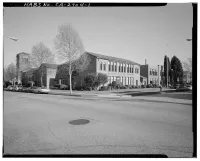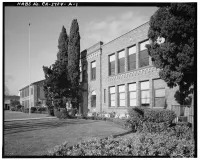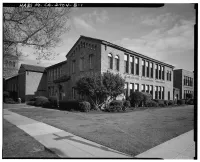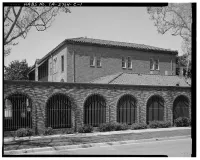Share what you know,
and discover more.
Share what you know,
and discover more.

-

- Marley Zielike
Beverly Vista School, 200 South Elm Dr, Beverly Hills, Los Angeles County, CA
At Beverly Vista, the Administration Building (Building A), the Auditorium/Manual Arts Building (Building B) and the Primary Building (Building C) are fine examples of public school design. The first building to be erected on campus, Building A, was designed by architect Francis J. Catton in the Italian Romanesque Revival style. Incorporating the distinguishing characteristics of this architectural idiom such as brick exterior walls, a tiled roof, an extensive and unifying use of arches as a decorative motif, and a tower which is reminiscent of ecclesiastical Romanesque precedents, the subsequent buildings, Buildings B and D, designed by the Los Angeles architectural firm of Gable and Wyant make Beverly Vista a noteworthy example of its property type. Gable and Wyant were particularly known for their work in the Spanish Colonial Revival style, as for example, in their design for Hangar I (1929) at the Los Angeles International Airport; Beverly Vista illustrates their facility with a different but related architectural vocabulary. The us of the Romanesque Revival style also represents a distinctly traditional choice of architectural imagery. While all of the other schools in the district showcase the Spanish style, that eventually became integral to the mythology of southern California, Beverly Vista suggests a more urban approach to school design and contains the three oldest extant public school buildings constructed by the District in Beverly Hills.
Beverly Vista School, 200 South Elm Dr, Beverly Hills, Los Angeles County, CA
At Beverly Vista, the Administration Building (Building A), the Auditorium/Manual Arts Building (Building B) and the Primary Building (Building C) are fine examples of public school design. The first building to be erected on campus, Building A, was designed by architect Francis J. Catton in the Italian Romanesque Revival style. Incorporating the distinguishing characteristics of this architectural idiom such as brick exterior walls, a tiled roof, an extensive and unifying use of arches as a decorative motif, and a tower which is reminiscent of ecclesiastical Romanesque precedents, the subsequent buildings, Buildings B and D, designed by the Los Angeles architectural firm of Gable and Wyant make Beverly Vista a noteworthy example of its property type. Gable and Wyant were particularly known for their work in the Spanish Colonial Revival style, as for example, in their design for Hangar I (1929) at the Los Angeles International Airport; Beverly Vista illustrates their facility with a different but related architectural vocabulary. The us of the Romanesque Revival style also represents a distinctly traditional choice of architectural imagery. While all of the other schools in the district showcase the Spanish style, that eventually became integral to the mythology of southern California, Beverly Vista suggests a more urban approach to school design and contains the three oldest extant public school buildings constructed by the District in Beverly Hills.
Beverly Vista School, 200 South Elm Dr, Beverly Hills, Los Angeles County, CA
At Beverly Vista, the Administration Building (Building A), the Auditorium/Manual Arts Building (Building B) and the Primary Building (Building C) are fine examples of public school design. The first building to be erected on campus, Building A, was designed by architect Francis J. Catton in the Italian Romanesque Revival style. Incorporating the distinguishing characteristics of this architectural idiom such as brick exterior walls, a tiled roof, an extensive and unifying use of arches as a decorative motif, and a tower which is reminiscent of ecclesiastical Romanesque precedents, the subsequent buildings, Buildings B and D, designed by the Los Angeles architectural firm of Gable and Wyant make Beverly Vista a noteworthy example of its property type. Gable and Wyant were particularly known for their work in the Spanish Colonial Revival style, as for example, in their design for Hangar I (1929) at the Los Angeles International Airport; Beverly Vista illustrates their facility with a different but related architectural vocabulary. The us of the Romanesque Revival style also represents a distinctly traditional choice of architectural imagery. While all of the other schools in the district showcase the Spanish style, that eventually became integral to the mythology of southern California, Beverly Vista suggests a more urban approach to school design and contains the three oldest extant public school buildings constructed by the District in Beverly Hills.Posted Date
Sep 27, 2021
Source Name
Library of Congress
Source Website
Delete Story
Are you sure you want to delete this story?

-

- Marley Zielike
Beverly Vista School, Administration Building, 200 South Elm Dr, Beverly Hills, Los Angeles County, CA
At Beverly Vista, the Administration Building (Building A) is a fine example of public school design. The first building to be erected on campus, Building A, was designed by architect Francis J. Catton in the Italian Romanesque Revival style. Incorporating the distinguishing characteristics of this architectural idiom such as brick exterior walls, a tiled roof, an extensive and unifying use of arches as a decorative motif, and a tower which is reminiscent of ecclesiastical Romanesque precedents. The use of the Romanesque Revival style also represents a distinctly traditional choice of architectural imagery. While all of the other schools in the Beverly Hills Unified School District showcase the Spanish style, that eventually became integral to the mythology of southern California, Beverly Vista suggests a more urban approach to school design. Built in 1924, Building A is the oldest extant public school building constructed by the District in Beverly Hills.
Beverly Vista School, Administration Building, 200 South Elm Dr, Beverly Hills, Los Angeles County, CA
At Beverly Vista, the Administration Building (Building A) is a fine example of public school design. The first building to be erected on campus, Building A, was designed by architect Francis J. Catton in the Italian Romanesque Revival style. Incorporating the distinguishing characteristics of this architectural idiom such as brick exterior walls, a tiled roof, an extensive and unifying use of arches as a decorative motif, and a tower which is reminiscent of ecclesiastical Romanesque precedents. The use of the Romanesque Revival style also represents a distinctly traditional choice of architectural imagery. While all of the other schools in the Beverly Hills Unified School District showcase the Spanish style, that eventually became integral to the mythology of southern California, Beverly Vista suggests a more urban approach to school design. Built in 1924, Building A is the oldest extant public school building constructed by the District in Beverly Hills.
Beverly Vista School, Administration Building, 200 South Elm Dr, Beverly Hills, Los Angeles County, CA
At Beverly Vista, the Administration Building (Building A) is a fine example of public school design. The first building to be erected on campus, Building A, was designed by architect Francis J. Catton in the Italian Romanesque Revival style. Incorporating the distinguishing characteristics of this architectural idiom such as brick exterior walls, a tiled roof, an extensive and unifying use of arches as a decorative motif, and a tower which is reminiscent of ecclesiastical Romanesque precedents. The use of the Romanesque Revival style also represents a distinctly traditional choice of architectural imagery. While all of the other schools in the Beverly Hills Unified School District showcase the Spanish style, that eventually became integral to the mythology of southern California, Beverly Vista suggests a more urban approach to school design. Built in 1924, Building A is the oldest extant public school building constructed by the District in Beverly Hills.Posted Date
Sep 27, 2021
Source Name
Library of Congress
Source Website
Delete Story
Are you sure you want to delete this story?

-

- Marley Zielike
Beverly Vista School, Manual Arts & Classroom Building, 200 South Elm Dr, Beverly Hills, Los Angeles County, CA
At Beverly Vista, the Auditorium/Manual Arts Building (Building B) is a fine example of public school design. Building B, was designed by the Los Angeles architectural firm of Gable and Wyant in the Italian Romanesque Revival style. Incorporating the distinguishing characteristics of this architectural idiom such as brick exterior walls, a tiled roof, an extensive and unifying use of arches as a decorative motif, and a tower which is reminiscent of ecclesiastical Romanesque precedents. Gable and Wyant were particularly known for their work in the Spanish Colonial Revival style, as for example, in their design for Hangar 1 (1929) at the Los Angeles International Airport. Beverly Vista illustrates their facility with a different but related architectural vocabulary. The use of the Romanesque Revival style also represents a distinctly traditional choice of architectural imagery. While all of the other schools in the district showcase the Spanish style, that eventually became integral to the mythology of southern California, Beverly Vista suggests a more urban approach to school design. Constructed in 1925, with an addition added in 1927, Building B is the second oldest extant public school building constructed by the District in Beverly Hills.
Beverly Vista School, Manual Arts & Classroom Building, 200 South Elm Dr, Beverly Hills, Los Angeles County, CA
At Beverly Vista, the Auditorium/Manual Arts Building (Building B) is a fine example of public school design. Building B, was designed by the Los Angeles architectural firm of Gable and Wyant in the Italian Romanesque Revival style. Incorporating the distinguishing characteristics of this architectural idiom such as brick exterior walls, a tiled roof, an extensive and unifying use of arches as a decorative motif, and a tower which is reminiscent of ecclesiastical Romanesque precedents. Gable and Wyant were particularly known for their work in the Spanish Colonial Revival style, as for example, in their design for Hangar 1 (1929) at the Los Angeles International Airport. Beverly Vista illustrates their facility with a different but related architectural vocabulary. The use of the Romanesque Revival style also represents a distinctly traditional choice of architectural imagery. While all of the other schools in the district showcase the Spanish style, that eventually became integral to the mythology of southern California, Beverly Vista suggests a more urban approach to school design. Constructed in 1925, with an addition added in 1927, Building B is the second oldest extant public school building constructed by the District in Beverly Hills.
Beverly Vista School, Manual Arts & Classroom Building, 200 South Elm Dr, Beverly Hills, Los Angeles County, CA
At Beverly Vista, the Auditorium/Manual Arts Building (Building B) is a fine example of public school design. Building B, was designed by the Los Angeles architectural firm of Gable and Wyant in the Italian Romanesque Revival style. Incorporating the distinguishing characteristics of this architectural idiom such as brick exterior walls, a tiled roof, an extensive and unifying use of arches as a decorative motif, and a tower which is reminiscent of ecclesiastical Romanesque precedents. Gable and Wyant were particularly known for their work in the Spanish Colonial Revival style, as for example, in their design for Hangar 1 (1929) at the Los Angeles International Airport. Beverly Vista illustrates their facility with a different but related architectural vocabulary. The use of the Romanesque Revival style also represents a distinctly traditional choice of architectural imagery. While all of the other schools in the district showcase the Spanish style, that eventually became integral to the mythology of southern California, Beverly Vista suggests a more urban approach to school design. Constructed in 1925, with an addition added in 1927, Building B is the second oldest extant public school building constructed by the District in Beverly Hills.Posted Date
Sep 27, 2021
Source Name
Library of Congress
Source Website
Delete Story
Are you sure you want to delete this story?

-

- Marley Zielike
Beverly Vista School, Primary Building, 200 South Elm Dr, Beverly Hills, Los Angeles County, CA
At Beverly Vista, the Primary Building (Building D) is a fine example of public school design. Building D, was designed by the Los Angeles architectural firm of Gable and Wyant in the Italian Renaissance Revival style. Incorporating the distinguishing characteristics of this architectural idiom such as brick exterior walls, a tiled roof, an extensive and unifying use of arches as a decorative motif, and a tower which is reminiscent of ecclesiastical Romanesque precedents. Gable and Wyant were particularly known for their work in the Spanish Colonial Revival style, as for example, in their design for Hangar I (1929) at the Los Angeles International Airport. Beverly Vista illustrates their facility with a different but related architectural vocabulary. The use of the Romanesque Revival style also represents a distinctly traditional choice of architectural imagery. While all of the other schools in the district showcase the Spanish style, that eventually became integral to the mythology of southern California, Beverly Vista suggest a more urban approach to school design. Constructed in 1926, Building D is the third oldest extant public school building constructed by the District in Beverly Hills.
Beverly Vista School, Primary Building, 200 South Elm Dr, Beverly Hills, Los Angeles County, CA
At Beverly Vista, the Primary Building (Building D) is a fine example of public school design. Building D, was designed by the Los Angeles architectural firm of Gable and Wyant in the Italian Renaissance Revival style. Incorporating the distinguishing characteristics of this architectural idiom such as brick exterior walls, a tiled roof, an extensive and unifying use of arches as a decorative motif, and a tower which is reminiscent of ecclesiastical Romanesque precedents. Gable and Wyant were particularly known for their work in the Spanish Colonial Revival style, as for example, in their design for Hangar I (1929) at the Los Angeles International Airport. Beverly Vista illustrates their facility with a different but related architectural vocabulary. The use of the Romanesque Revival style also represents a distinctly traditional choice of architectural imagery. While all of the other schools in the district showcase the Spanish style, that eventually became integral to the mythology of southern California, Beverly Vista suggest a more urban approach to school design. Constructed in 1926, Building D is the third oldest extant public school building constructed by the District in Beverly Hills.
Beverly Vista School, Primary Building, 200 South Elm Dr, Beverly Hills, Los Angeles County, CA
At Beverly Vista, the Primary Building (Building D) is a fine example of public school design. Building D, was designed by the Los Angeles architectural firm of Gable and Wyant in the Italian Renaissance Revival style. Incorporating the distinguishing characteristics of this architectural idiom such as brick exterior walls, a tiled roof, an extensive and unifying use of arches as a decorative motif, and a tower which is reminiscent of ecclesiastical Romanesque precedents. Gable and Wyant were particularly known for their work in the Spanish Colonial Revival style, as for example, in their design for Hangar I (1929) at the Los Angeles International Airport. Beverly Vista illustrates their facility with a different but related architectural vocabulary. The use of the Romanesque Revival style also represents a distinctly traditional choice of architectural imagery. While all of the other schools in the district showcase the Spanish style, that eventually became integral to the mythology of southern California, Beverly Vista suggest a more urban approach to school design. Constructed in 1926, Building D is the third oldest extant public school building constructed by the District in Beverly Hills.Posted Date
Sep 27, 2021
Source Name
Library of Congress
Source Website
Delete Story
Are you sure you want to delete this story?










